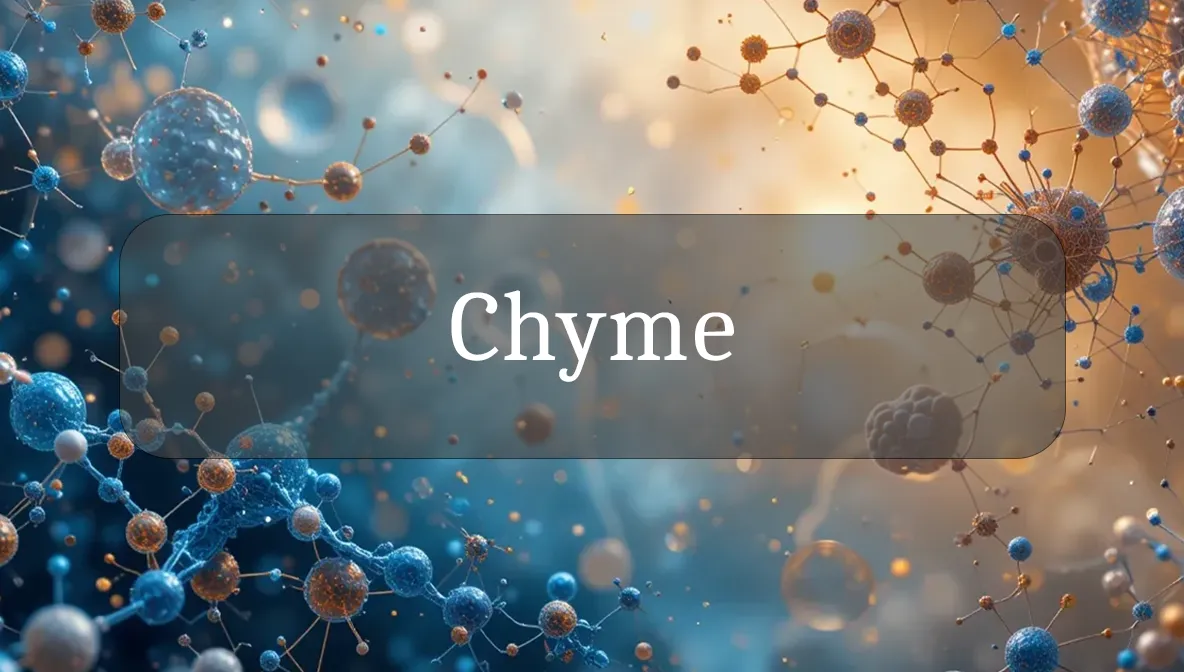Body’s Digestive Soup for Nutrient Power
Chyme is the soupy mix of partially digested food, stomach acids, and enzymes that your body creates during digestion. It’s a key player in turning your meals into fuel, helping you absorb nutrients to stay energized and healthy. Let’s dive into what chyme is, why it matters for your wellness, and how to support its role in your daily health.
Identity and Function
Chyme is a semi-liquid mixture formed in your stomach as food is broken down by gastric juices, including hydrochloric acid and enzymes like pepsin. It’s the result of your stomach churning and mixing food into a consistency that your small intestine can handle for nutrient absorption. Chyme contains partially digested proteins, carbs, and fats, along with water and electrolytes, and it moves from your stomach to your intestines to deliver nutrients to your body.
Health Benefits and Physiological Role
Chyme is like a nutrient-packed delivery system that supports your vitality:
- Nutrient Breakdown: It prepares food for absorption by breaking it into smaller molecules, ensuring your body gets energy from carbs, building blocks from proteins, and healthy fats for cell repair.
- Absorption Prep: In the small intestine, chyme triggers the release of digestive enzymes and bile, which further break down nutrients for absorption into your blood.
- Gut Motility: Chyme’s movement through your digestive tract promotes regular bowel movements, keeping your gut comfortable and efficient.
- pH Balance: Chyme’s acidity in the stomach helps kill harmful bacteria in food, protecting your gut from infections.
- Energy and Growth: By delivering nutrients, chyme supports everything from muscle strength to brain focus, keeping you active and alert.
Chyme is essential for turning your meals into the energy and nutrients you need to thrive.
Production and Sources
Chyme is produced naturally in your stomach during digestion:
- How It’s Made: After you eat, your stomach mixes food with gastric juices (acid, enzymes, and mucus) through churning motions, creating chyme in 2–4 hours, depending on the meal.
- Dietary Influence: What you eat affects chyme’s composition. High-fiber foods (veggies, whole grains) create bulkier chyme, while fatty or protein-rich meals (meat, oils) take longer to process.
- Key Players: Your stomach, liver (via bile), and pancreas (via enzymes) work together to form and process chyme in the small intestine.
- No External Sources: Chyme isn’t consumed; it’s made from your diet, so eating a variety of nutrient-rich foods ensures healthy chyme production.
A balanced diet with proteins, carbs, fats, and fiber supports optimal chyme formation.
Signs of Imbalance
Issues with chyme production or processing often signal digestive problems:
- Slow Digestion:
- Bloating, fullness, or stomach pain after eating (possible delayed gastric emptying).
- Nausea or vomiting if chyme doesn’t move properly.
- Fast Digestion:
- Diarrhea or loose stools if chyme passes too quickly through the intestines.
- Poor nutrient absorption, leading to fatigue or weight loss.
- Acid Imbalance:
- Heartburn or acid reflux if chyme is too acidic or backs up into the esophagus.
- Stomach discomfort if acid levels are too low, impairing digestion. If you experience persistent bloating, pain, or changes in bowel habits, see a doctor to check for conditions like gastritis, IBS, or gastroparesis.
Supporting Healthy Function
To keep chyme production and digestion running smoothly:
- Eat a Balanced Diet: Include fiber-rich foods (fruits, veggies, whole grains), lean proteins (chicken, tofu), and healthy fats (avocado, nuts) to create well-formed chyme.
- Chew Thoroughly: Chewing food well breaks it down before it reaches your stomach, making chyme easier to process.
- Stay Hydrated: Drink 8–10 cups of water daily to keep chyme at the right consistency for smooth digestion.
- Eat Smaller Meals: Large meals can overwhelm your stomach, slowing chyme formation. Opt for smaller, frequent meals if digestion feels sluggish.
- Support Gut Health: Probiotics (from yogurt or supplements) and fiber help maintain a healthy gut environment for chyme processing.
Safety and Precautions
Chyme is a natural part of digestion, but digestive health requires care:
- Medical Conditions: Conditions like ulcers, acid reflux, or small intestinal bacterial overgrowth (SIBO) can disrupt chyme processing. Work with a doctor to manage these.
- Food Sensitivities: If certain foods (e.g., dairy, gluten) cause bloating or diarrhea, chyme may not form properly. Consider food intolerance testing.
- Medications: Drugs like antacids or PPIs (for acid reflux) can alter chyme’s acidity, affecting digestion. Use only as prescribed.
- Hygiene: Avoid contaminated food or water to prevent infections that could disrupt chyme production or gut health.
If you have ongoing digestive issues, consult a healthcare provider for tests like endoscopy or motility studies.
Fun Fact
Did you know chyme’s name comes from the Greek word “khymos,” meaning juice? Ancient Greeks recognized its soupy texture as a key step in digestion, and modern science agrees it’s like a nutrient smoothie for your body!
Citations
- National Institutes of Health (NIH): Digestive System and Nutrient Absorption.
- Mayo Clinic: Digestion and Gastrointestinal Health.
- Cleveland Clinic: Understanding Stomach Function.
- World Health Organization (WHO): Nutrition and Digestive Health.
- Harvard Medical School: Gut Health and Digestion Basics.

